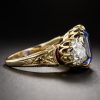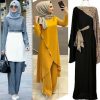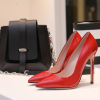You can choose from a large variety of vintage styles to dress in today. They are different depending on the decade that they were in as the top of the fashion world, or as a necessity at that time. In addition, it may be useful to take your jewelry and learn how to polish silver jewellery at home so you can keep it clean and looking like the day it was purchased: even though it is vintage.
1940’s Vintage Fashions
In the 1940s as World War II raged on, the fashion designers quit designing any clothing from 1939 to 1945. The government also set limits on how much materials such as wool, nylon, and cotton a woman could buy to make her own clothing. This forced women to adapt by improvising and getting creative with their wardrobe choices.
Knee-Length Coats
The era of knee-length coats is in the 1940s due to the fabric restrictions. This allowed women to make their own coats in a shorter style than in the 1930s when they were floor length. Some women that still had their older full-length coats would simply cut them to knee length to be fashionable.
Knee-length coats will always be stylish for modern women. You can find these coats in many colors, prints and with embellishments today which were not common in the past. A simple A-line coat with pleats and a belt is very flattering to any body shape.
Floral Dresses
The 1930s was a time for feminine, elegant dresses in fresh floral designs and silky drapes of floor length dresses. However, when the war began in 1939, these types of dresses were replaced with simple, boxy cut plain colored dresses and masculine blazers with wider shoulders and in knee length.
From this change, the trend became famous for the short-sleeved and knee-length dresses made of cool rayon. Rayon was the least war-rationed material so it made sense to use it to hand tailor a few beautiful dresses. Floral dresses of this type were worn in the 1940s for special occasions, but today the floral dresses are seen as sweet and casual, especially when you accessorize with a vintage straw purse, a forest green vintage hat, nude flats, and bright red lipstick and fingernails.
Pencil Skirts
The 1940s introduced pencil skirts due to the material shortages. In 1942, the War Production Board announced that jackets could be no longer than 25 inches in length, pants could be no more than 19 inches in circumference at the hemline, belts could not exceed two inches wide and heels could only be one inch tall.
These restrictions allowed the pencil skirt to be born at knee length and close fitting to accommodate the measurements they had to adhere to. Today, women worldwide wear the pencil skirt as a professional style in the workplace.
Masculine Suits
Since fashions were discouraged from having any types of details to decorate them such as lace and ruffles, Americans were inspired to the utilitarian design of men’s suits. The simple boxy styling resembled the military style suits.
Women began taking their husband’s older suits and transforming them into a woman’s suit, dresses and clothing for their children. This was a great way to reuse and recycling clothing by repurposing them into new garments for the entire family. Today, the 1940’s inspired blazer looks fabulous when you pair it with dress pants, skirts or skinny jeans.
Scarves
If you have ever seen a photo of Rosie the Riveter, you will be reminded of her hairstyle with a historic scarf when women worked in the factories and shipyards during World War II. The style includes a patterned scarf placed at the back of your head and pulled forward into a knot at the front of your forehead. The objective was to keep hair away from machinery.
Today the same style of hair scarf gives you a unique flair to add a punch of print to any feminine, tailored appearance. You can tie the knot as small or large as you see fit and wear your hear in an up-swept hairdo or a loose bun.
The End of World War II Fashions
When World War II ended in late 1945, island prints and polka dots became very popular, as the men returning from war brought these types of materials home to their wives to create new clothing. Gingham fabric was very popular as well as ruffles on blouses.
You can mix and match vintage items from different eras to coordinate a new wardrobe for yourself. You do not need to stick to an entire outfit in one era or it could look more like a costume. Here are some examples of what to find from which era:
- The 1900’s-Voluminous lace gowns, collared tops, and corsets
- The 1910’s-Lace up boots for women and trench coats
- The 1920’s-Slip dresses, flapper dresses, and beaded fascinators
- The 1930’s-Wide-brimmed hats and fur collars
- The 1940’s-Pastel sweaters, halter-tops, and cigarette-style pants
- The 1950’s-Poodle skirts, circle skirts, leather jackets, and unitards
- The 1060’s-Bell bottom jeans, paisley shirts, and peace signs
- The 1970’s-Denim and natural tones, leg warmers, and pantsuits
- The 1980’s-Shoulder pads, lacy, frilly tops, neon colors and tunics with leggings
How to Get Started Wearing Vintage Clothing
Start with choosing a vintage top that is older than the 70’s or ’80s. If a top is of this era it may look like you are wearing out of style clothing. Choose a few older tops and consider a shirt or sweater that is too large to match with tight bottoms or a wide belt to flatter your figure.
Choose a vintage skirt in any neutral tone of gray, black, brown, tan or olive. This allows you to pair it easily with a modern or vintage blouse.
Pair vintage-inspired fashion pants with a modern banded t-shirt or an oversized sweater. You can tuck a lacy top or a screen-printed t-shirt in at the waistline to add a modern flair to your vintage bottoms.
You can also just add vintage hats and scarves to all of your modern outfits. Some of the best vintage hats are wide brim, which is very popular today. You can do a lot with a beautiful silk scarf. It can be worn around your neck or wrapped on your head. (Free Viagra)
Vintage jewelry will never go out of style. You can look for bold bangles, big statement necklaces or clip-on earrings. Don’t wear more than one statement piece at a time though. You don’t want your jewelry to compete with your outfit of choice.
Add shoes to your wardrobe that are vintage inspired. You can find a classic style such as lace-up boots or oxford flats and add them to your modern wardrobe. It is probably best to stick to neutral colors in quality leather so they will go with almost anything you wear and will be long-lasting.
The history of the evolution of vintage clothing is an interesting subject, especially when you find out why certain vintage fashions came about. These tips and tricks on vintage fashion and how to wear them can help you to transform your entire wardrobe one piece at a time to bring vintage to your modern closet of clothing.
Author Bio:
Jenny Larson has a degree in journalism and has over 10 years experience in writing. Her specialty lies in the plus size market, as she is a curvy woman herself. She writes candidly on many subjects that plus size women face on a daily basis, such as how to choose the perfect clothing for any occasion that compliments a specific body type. Her passion is fashion, clothing, hair, and makeup and she writes from an insider’s view on these subjects.
Learn more about Car Service to Newark Airport from NYC newarkairportcarservice at newarkairportcarservice







